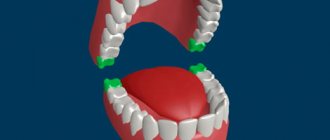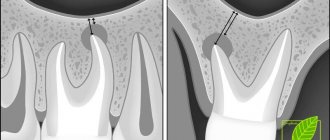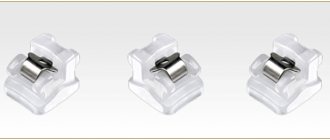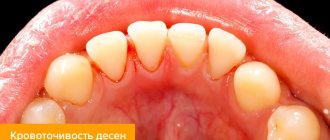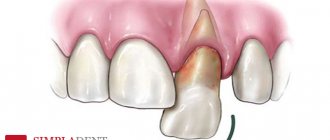An implant is a multicomponent system consisting of an intraosseous element and an abutment, an adapter between an artificial root and a prosthesis. The implant/abutment connection is precisely calibrated, without micro-gaps, with well-designed abutment positioning. These are important factors on which the correct distribution of the chewing load on the implant and the durability of the orthopedic system depend.
When a crown on an implant is loose, there is always a reason for it. If the implant itself remains motionless, most likely the fixing screw has been loosened or the crown has become uncemented (if it is cemented).
What to do? Go to an appointment with an orthopedist, who will determine the cause of the looseness and effectively solve the problem - replace the fixing component or reinstall the crown. The main thing is to accurately install a loose implant or crown. Indeed, in the first situation, reimplantation may be required, and the second option involves a simple adjustment of the coronal part; the implant itself does not need to be changed.
Reasons for crown mobility
In most cases, the mobility of the prosthesis has nothing to do with the qualifications of the implantologist. Among the main reasons are:
- Loosening of the screw connection between the abutment and the prosthesis
. This is possible if products from different brands were used. For example, the implant is Nobel Biocare, and the superstructure is Osstem. It is important to use original products of the same brand, which are developed as a whole, otherwise the likelihood of failure of all components is too high. - Loss of properties of the cement composition
. As a rule, this occurs due to high chewing load on the tooth, adherence to too hot or cold foods. The prosthetic system is fixed to the abutment with a soft cement composition; under unfavorable conditions, it begins to collapse, is gradually washed out, and the crown becomes loose.
The crown can be reattached in the clinic where the implantation was performed. The orthopedist will tighten the screw with an implantation key and secure the prosthesis. With the cement method of fastening, the crown will be cleaned of the remnants of the old composition and “set” on the cement again. Things are different if not only the crown, but the implant along with it is loose. It is very difficult to independently determine whether the implant crown is loose or the fixation of the intraosseous element is weakened. This requires a medical assessment of the clinical picture and a diagnostic examination.
Description of material
A metal-ceramic crown is made from a metal alloy and then covered with porcelain. In this case, the frame can be made of several noble metals at the same time or simply of cobalt, nickel, chromium. It is these materials that provide the structure with the necessary strength, so the tooth and jaw as a whole can function normally. The ceramic layer is responsible for aesthetics.
Replacing teeth with ceramics is considered one of the most reliable and durable options. But, as a rule, they are the ones most often exposed to chips and various damages. Therefore, you need to know what to do if a piece of a metal-ceramic crown breaks off. The fact is that ignoring this problem can destroy it completely in a short time.
This is especially true for those people who do not follow medical recommendations and consume solid foods. Such abuse often violates the integrity of the tooth: first, microcracks form on it, and later chips appear.
Implant mobility due to patient negligence
The main reason why the intraosseous structural element began to wobble is ignoring the recommendations regarding the care of implants and the orthopedic system fixed to them. If the surgeon performed the implantation without violating the protocol, 90% of the responsibility for rehabilitation lies with the patient. The following can lead to loosening of the structure:
- Refusal of medications prescribed by the surgeon for the speedy restoration of injured tissue, prevention of the inflammatory process, etc.
- Regular consumption of alcohol and smoking slow down the rate of engraftment of the artificial root, increases the risk of peri-implantitis, and impairs blood circulation in the tissues. Clinical studies have shown that implant failure in patients with bad habits is 3 times higher than in those who do not have them.
- Overload of the artificial root when chewing hard foods. Premature chewing load on the implant. Typically, the doctor recommends following a soft diet for 2-3 weeks after the intervention. Ignoring the recommendation leads to displacement of the implant in its bed, disruption of osseointegration and, as a consequence, rejection of the intraosseous element.
The survival rate of a titanium structure is also affected by systemic diseases accompanied by impaired regenerative processes. These include diabetes mellitus, immunodeficiency states, oncological processes, some pathologies of the central nervous system, and chronic processes in the oral cavity.
How to make artificial teeth last longer
To avoid the problem of “flying” dentures, the patient first needs to contact an experienced orthopedic dentist who will help create a high-quality and precisely fitting structure. It is also important that the clinic has its own dental laboratory equipped with modern equipment.
Another aspect that must be taken into account is the careful attitude towards restorations on the part of the patient himself. With new teeth, you cannot chew nuts, candies, bite off pieces of hard vegetables and fruits, chew toffees, or toffees. Care should be carried out as if you were caring for your own teeth - use a toothbrush with toothpaste without abrasives 2-3 times a day. After each meal, you should rinse your mouth, especially if you have eaten soft cookies or brightly colored foods - berries, carrots, beets, or drank strong coffee. Then the restored smile will not only not cause inconvenience to its owner, but will also retain its aesthetic appearance.
What treatment methods are used
Treatment for mobility of the structure depends on the cause of the problem. If the implant crown is loose and the intraosseous element itself is motionless, it is again secured with a screw or cement. When the entire structure is wobbly, including the artificial root, treatment tactics are selected according to the clinical picture. The most favorable option is that the implant wobbles slightly, there is no inflammation around it, and the gums do not hurt.
In the second scenario, loosening of the artificial root occurs against the background of inflammation and pain in the jaw. Treatment includes:
- Cleaning the implant and nearby tissues - opening abscesses (if any), ultrasonic cleaning of plaque in the subgingival area.
- Osteoplasty using osteoplastic material and barrier membranes (according to indications).
- Antibacterial, antihistamine, anti-inflammatory agents.
- Treatment of the oral cavity with antiseptic compounds.
- X-ray control at each stage of treatment.
After the inflammation is eliminated, the prosthesis is again fixed to the implant. If the intraosseous element is rejected, it is removed from the socket, necrotic tissue is removed, and bone grafting is performed. Re-implantation is possible only after 6-8 months, when the bone mass has taken root and the tissue has recovered to its parameters.
Recovery after removal
Restoring a ceramic prosthesis is quite difficult, and only a professional can do such work efficiently. The fact is that when removed, the crown may be damaged or completely destroyed, and it will be impossible to restore the product in order to glue it back. To carry out such events you will need tools and special devices:
- a device equipped with a tip that resembles a crochet hook;
- separator bolt;
- pneumatic hand tools;
- mechanical devices for removing the prosthesis from the mouth;
- spitting utensils;
- forceps.
The manipulations are carried out under local anesthesia, so the patient should not experience pain. Immediately after removal, the denture is sent to a special laboratory, where a dental technician will carefully examine the structure and restore the product. The entire recovery procedure usually lasts no longer than 3-5 hours.
It also happens
If a small chip has formed and the separated part is preserved, then it is simply glued to its original place using medical quick-drying glue. If the fragment is lost, then several ceramic layers are applied to the crown, thereby giving the tooth the required shape. After this, all that remains is to dry the prosthesis; this is done under the influence of high temperature in a special oven.
At the final stage, the technician grinds off excess fragments, grinds the crown and carries out final polishing. But this method is used extremely rarely, since the percentage of prosthesis removal without damage is extremely low. In addition, there is a high probability of injury to the gums and soft mucosal tissues. It is impossible to guarantee that such a design will last a long time, even if the work is done efficiently and professionally.
Rejection symptoms
Rejection of the intraosseous element is a serious complication leading to the loss of the metal pin. Usually, implant rejection is accompanied by quite eloquent symptoms:
- Swelling of the gums, which does not decrease within 5 days after the intervention, but, on the contrary, increases.
- Reddened mucous membrane around the artificial root.
- Severe pain that intensifies with any load on the structure.
- Bleeding of the gums around the implant for more than 4-5 days after implantation.
- Purulent discharge from a wound.
- The appearance of a putrid odor from the implantation area.
- Excessive mobility of the artificial root, exposure of its neck, subsidence of the gums.
- Deterioration in general health, increase in temperature.
A loose implant crown is a reason to urgently go to the dentist. Rejection is rarely treated. With such symptoms, the best option is to remove the implant from the bone with further drug therapy aimed at restoring the body and regenerating bone tissue.
The implant fell out, what should I do?
In rare cases, the implant becomes unscrewed from the bone and may fall out. This occurs when the size of the socket and the intraosseous element do not match, as well as due to the weakness of the jaw bone. Such situations, when the implant loses its fixation and falls out, but there is no inflammation or other signs of rejection, can occur against the background of systemic diseases in which tissue regeneration is impaired (osteoporosis, diabetes mellitus). The problem is solved by reinstalling the structure using regenerative membranes (enriched with growth factors) that accelerate osseointegration, and prescribing a course of vitamin therapy.
When the old denture cannot be glued into place
In a situation where a crown has fallen off a tooth, in the vast majority of cases it is not possible to fix it back. This is mainly because it is quite difficult to remove hardened cement from the support or from the inside of the “cap” without damaging living tissue or the material of the prosthesis. The structure itself will eventually “sit” loosely on the support (since the stump has been ground again), or after 1-2 months the person will notice that the dental crown is falling off again. Also, the dentist may refuse to install the fallen prosthesis back if there are factors that will be discussed below.
Complex on 4 OSSTEM implants with delayed loading - from RUB 170,000.
Complex implantation Osstem (South Korea) with delayed loading after 4-6 months.
Guarantee for the doctor’s work - unlimited Call now or order a call
Opening hours: 24 hours a day - seven days a week
The prosthesis fell out along with the pin or stump insert
The pins and stump inlays are installed with the lower edge into the canals of the dental roots and secured with cement. And it is impossible to remove cement from narrow roots without dissecting part of your own tissues. Those. you will have to make a new inlay, because it must fit tightly to the walls of the canals (as well as a prosthesis, which inside repeats the shape of the top of the inlay). The pins have a standard shape, not a custom one, but they are very thin and often break off in the canal, i.e. With the prosthesis, only part of the pin falls out, while the other remains “walled up” in the canal. There is only one way out - to remove the entire tooth.
There is inflammation or cracks in the stump or root
A doctor can easily determine the presence of caries by darkened enamel, dentin, and a carious cavity on the stump. This requires drilling out all affected tissues, restoring the shape of the support and strengthening it (for example, with a filling or stump inlay). But it will not be possible to exactly repeat the original form.
Caries and cracks in the roots are detected using X-ray diagnostics or more accurate computed tomography. Depending on the situation, the dentist either goes through the canals, strengthens them with pins and fills them, or installs a core inlay, which will give strength to the restoration. Of course, it is impossible to reinstall the old structure in these situations.
Not only the prosthesis fell out, but the entire tooth along with the root
This happens in severe forms of periodontitis, periodontal disease, with massive cysts and granulomas at the roots. These formations appear against the background of the penetration of infection from the root canal into the periodontium - the ligamentous apparatus connecting the root to the bone socket. If a tooth falls out, you need to select a different type of prosthesis.
Prevention
The best treatment is prevention. The positive outcome of the operation is influenced by:
- Professional approach
– you need to take the choice of a clinic and an implantologist seriously, since the success of treatment depends 90% on the professionalism of the doctor. - Quality of diagnosis and preparation
- you need to prepare seriously for the operation, eliminating all contraindications. To do this, you need to undergo tests and not hide health problems from the surgeon - the more the doctor knows about the patient’s health condition, the more accurately he will select the implantation protocol, and the better the implantation of the artificial root will be. - Oral hygiene
– at the preparation stage, all dental problems should be eliminated and the quality of hygiene procedures performed should be improved.
After implantation, be sure to follow medical recommendations regarding care, nutrition, and physical activity. Do not skip control and preventative examinations.
